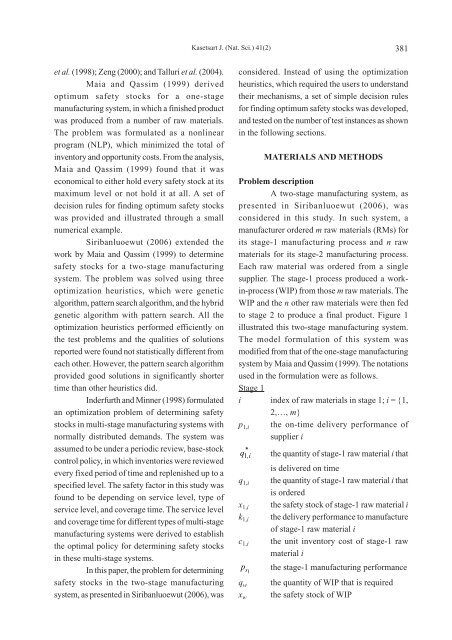April - June 2007 - Kasetsart University
April - June 2007 - Kasetsart University
April - June 2007 - Kasetsart University
You also want an ePaper? Increase the reach of your titles
YUMPU automatically turns print PDFs into web optimized ePapers that Google loves.
et al. (1998); Zeng (2000); and Talluri et al. (2004).<br />
Maia and Qassim (1999) derived<br />
optimum safety stocks for a one-stage<br />
manufacturing system, in which a finished product<br />
was produced from a number of raw materials.<br />
The problem was formulated as a nonlinear<br />
program (NLP), which minimized the total of<br />
inventory and opportunity costs. From the analysis,<br />
Maia and Qassim (1999) found that it was<br />
economical to either hold every safety stock at its<br />
maximum level or not hold it at all. A set of<br />
decision rules for finding optimum safety stocks<br />
was provided and illustrated through a small<br />
numerical example.<br />
Siribanluoewut (2006) extended the<br />
work by Maia and Qassim (1999) to determine<br />
safety stocks for a two-stage manufacturing<br />
system. The problem was solved using three<br />
optimization heuristics, which were genetic<br />
algorithm, pattern search algorithm, and the hybrid<br />
genetic algorithm with pattern search. All the<br />
optimization heuristics performed efficiently on<br />
the test problems and the qualities of solutions<br />
reported were found not statistically different from<br />
each other. However, the pattern search algorithm<br />
provided good solutions in significantly shorter<br />
time than other heuristics did.<br />
Inderfurth and Minner (1998) formulated<br />
an optimization problem of determining safety<br />
stocks in multi-stage manufacturing systems with<br />
normally distributed demands. The system was<br />
assumed to be under a periodic review, base-stock<br />
control policy, in which inventories were reviewed<br />
every fixed period of time and replenished up to a<br />
specified level. The safety factor in this study was<br />
found to be depending on service level, type of<br />
service level, and coverage time. The service level<br />
and coverage time for different types of multi-stage<br />
manufacturing systems were derived to establish<br />
the optimal policy for determining safety stocks<br />
in these multi-stage systems.<br />
In this paper, the problem for determining<br />
safety stocks in the two-stage manufacturing<br />
system, as presented in Siribanluoewut (2006), was<br />
<strong>Kasetsart</strong> J. (Nat. Sci.) 41(2) 381<br />
considered. Instead of using the optimization<br />
heuristics, which required the users to understand<br />
their mechanisms, a set of simple decision rules<br />
for finding optimum safety stocks was developed,<br />
and tested on the number of test instances as shown<br />
in the following sections.<br />
MATERIALS AND METHODS<br />
Problem description<br />
A two-stage manufacturing system, as<br />
presented in Siribanluoewut (2006), was<br />
considered in this study. In such system, a<br />
manufacturer ordered m raw materials (RMs) for<br />
its stage-1 manufacturing process and n raw<br />
materials for its stage-2 manufacturing process.<br />
Each raw material was ordered from a single<br />
supplier. The stage-1 process produced a workin-process<br />
(WIP) from those m raw materials. The<br />
WIP and the n other raw materials were then fed<br />
to stage 2 to produce a final product. Figure 1<br />
illustrated this two-stage manufacturing system.<br />
The model formulation of this system was<br />
modified from that of the one-stage manufacturing<br />
system by Maia and Qassim (1999). The notations<br />
used in the formulation were as follows.<br />
Stage 1<br />
i index of raw materials in stage 1; i = {1,<br />
2,…, m}<br />
p1,i the on-time delivery performance of<br />
supplier i<br />
*<br />
q1, i<br />
q 1,i<br />
x1,i k1,i c 1,i<br />
p s1<br />
qw xw the quantity of stage-1 raw material i that<br />
is delivered on time<br />
the quantity of stage-1 raw material i that<br />
is ordered<br />
the safety stock of stage-1 raw material i<br />
the delivery performance to manufacture<br />
of stage-1 raw material i<br />
the unit inventory cost of stage-1 raw<br />
material i<br />
the stage-1 manufacturing performance<br />
the quantity of WIP that is required<br />
the safety stock of WIP
















